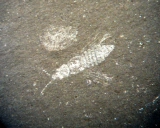 For almost a year now, I’ve been alluding to research on squirrels, but I didn’t want to go into detail until the results were published. That paper was finally released online yesterday, so now I’m free to discuss it. This requires a bit of background, however.
For almost a year now, I’ve been alluding to research on squirrels, but I didn’t want to go into detail until the results were published. That paper was finally released online yesterday, so now I’m free to discuss it. This requires a bit of background, however.
I’m one of five curators currently on staff at VMNH. Curator of Mammalogy Nancy Moncrief has for many years been studying biogeographic patterns in the eastern fox squirrel, Sciurus niger (above), mostly by looking at marker genes. S. niger is an interesting species for this work because there are numerous subspecies that vary greatly in body size and coat color:
That’s a lot of variation! What makes it really interesting is that S. niger is a temperate species that doesn’t tolerate cold weather very well (they don’t hibernate). That means that their range was probably very restricted in the Pleistocene during the last glacial maximum, suggesting that all that phenotypic diversity may have arisen in less than 10,000 years.
I’ve not been involved in Nancy’s research, but because I do some biogeographic work Nancy would occasionally ask me to read her manuscripts or listen to her lectures to provide feedback from a paleontologist’s perspective. As a result I was somewhat familiar with her work.
Then, in 2009, I was asked to write a book chapter reviewing the published record of vertebrate fossils in Virginia. While tabulating these species I noticed that, while the genus Sciurus had been reported from the Virginia Pleistocene, there were no reports of S. niger. Almost all the records were listed as Sciurus sp.
Realizing that being able to tell when fox squirrels show up in different places could be useful for Nancy’s work, I asked her about the lack of definitive species-level identifications. The problem, she explained, is that it’s really difficult to distinguish S. niger from the closely related, sympatric, eastern gray squirrel (Sciurus carolinensis, below) when only the skeleton is available.
 The problem is that tree squirrels are pretty conservative in their skeletal morphology, especially in the postcranial skeleton, with few changes since the Miocene at least. The average size and maximum size of fox squirrels are greater than in gray squirrels. However, there is considerable overlap; the largest gray squirrels are bigger than the smallest fox squirrels. So using body size for identification only works for really big specimens.
The problem is that tree squirrels are pretty conservative in their skeletal morphology, especially in the postcranial skeleton, with few changes since the Miocene at least. The average size and maximum size of fox squirrels are greater than in gray squirrels. However, there is considerable overlap; the largest gray squirrels are bigger than the smallest fox squirrels. So using body size for identification only works for really big specimens.
There are also some detail differences in the skull and mandible, but they tend to be somewhat inconsistent. Easily the most reliable feature is the presence of a rudimentary upper 3rd premolar in S. carolinensis, which is absent in S. niger. Below is the upper right tooth row of S. carolinensis, top, and S. niger, bottom. In each specimen anterior is to the right. Note the tiny, peg-like premolar at the front of the tooth row in S. carolinensis only:
Unfortunately, it’s pretty rare to preserve that particular part of the maxilla, so the extra premolar is of limited use in identifying isolated bone fragments in Pleistocene deposits. In an irrational fit of optimism, I suggested to Nancy that I might be able to come up with features for distinguishing between the two species based on isolated material, especially since VMNH has hundreds of modern squirrel skeletons in our collections to use as references.
After several frustrating days looking at squirrel bones, I was ready to give up. There simply don’t seem to be any consistent features for distinguishing postcranial remains other than size, which is unreliable. Then, as Nancy and I sat together discussing squirrel trivia, she asked if I knew that fox squirrel bones glow pink under ultraviolet light. It hit us both at the same time; only fox squirrel bones fluoresce under UV light! Here’s an S. niger skull under visible light (left), and the same skull under UV light (right):
So here’s the deal: eastern fox squirrels almost universally have a genetic condition called congenital erythropoietic porphyria (CEP). This is caused by a mutation in one of the genes involved in the heme chain (heme is a key component of hemoglobin). Specifically, animals with CEP can’t properly metabolize the enzyme uroporphyrin, which as a result starts to build up in the urine, bones, and teeth. Uroporphyrin fluoresces pink when exposed to ultraviolet light.
As I mentioned above, CEP is normally not present in gray squirrels, so we can potentially use the presence of fluorescence to distinguish between fox and gray squirrels, even when there’s a size overlap. For example, the skulls below are organized by increasing size from left to right. Which ones are S. niger, and which ones are S. carolinensis?
Here are the same skulls under UV light:
The 2nd, 4th, and 5th skulls all fluoresce, and are all fox squirrels.
CEP has been reported as a rare condition in several different mammal species, including humans. It’s typically a pretty dreadful condition that results in photosensitivity, skin lesions, and anemia among other problems. For some unknown reason, eastern fox squirrels don’t seem to suffer from the adverse effects of CEP even though they have elevated uroporphyrin levels.
Biologists have known since the 1930’s that fox squirrels have fluorescent bones (Turner, 1937), and that sometimes they’re even pink under visible light. There were a few studies in the 1970’s looking at the condition in some detail (Levin and Flyger 1971, for example), but somehow this knowledge was never applied to fossil remains. The question, of course, is that since a particular protein is responsible for the fluorescence, would it still be detectable in ancient specimens? That’s what we set out to test in our current paper.
The Florida Museum of Natural History lists several specimens of S. niger among their Pleistocene/early Holocene collections, and they happened to be the host for last year’s SeAVP meeting. The day before the meeting I spent a few hours in their collection with a tray of squirrel bones from Devil’s Den Sinkhole and a UV light. Sure enough, even though these bones have been sitting at the bottom of a sinkhole (that’s currently flooded) for at least 7,000 years*, several of the bones still fluoresce. The best example was this partial skull:
There’s definitely a high “coolness” factor here; we diagnosed a genetic condition in a late Pleistocene/early Holocene squirrel! But in addition to that, we’ve given ourselves a pretty powerful tool for examining ancient squirrels. To be sure, there are limitations: the fluorescence seems to disappear if the bones have been mineralized, and the condition may not be truly universal in S. niger. Therefore, this only works as a positive test for the presence of S. niger; the absence of fluorescence doesn’t definitively tell us anything. But on the other hand, this allows us to identify even fragmentary postcranial remains, the test is non-destructive and inexpensive, and the results are immediate. And it’s spectacularly easy to use on mixed bone deposits, including samples obtained by screening. Here’s a sample of bones from multiple taxa obtained by screening a sediment sample from a late Holocene site:
And here’s the same sample under UV:
 A dozen of these bones turned out to be fox squirrel (some of them are hard to spot in a photograph). They include difficult-to-identify elements like ribs; notice the two at the bottom center of the photo.
A dozen of these bones turned out to be fox squirrel (some of them are hard to spot in a photograph). They include difficult-to-identify elements like ribs; notice the two at the bottom center of the photo.
So what’s next? We’re still refining the technique itself in various ways. For example, our Devil’s Den experiments used a UV lamp that emits at 366 nm, which is common for DNA work. We’ve since learned that the bones fluoresce much more strongly at 400 nm, so we’re now using inexpensive UV flashlights that emit at that wavelength. We’ve also found, both in the literature and from our own observations, that not all fox squirrels fluoresce equally, and a minority don’t seem to fluoresce at all. Why? Are some populations more prone to CEP, is there an ontogenetic component to uroporphyrin levels, or is there just a significant amount of individual variation? Moreover, certain elements seem to fluoresce particularly well (for example, the maxillae, the dentaries, the incisors, and the 4th upper premolars) while others often don’t fluoresce at all (like the nasals and the molars).
Even with all those questions, we’re moving ahead with trying to identify fox squirrels in other deposits, both from Holocene and Pleistocene sites. We’ll also be presenting posters on this at upcoming meetings, including the Southeastern Section Meeting of GSA next month.
Full reference:
Dooley, A. C. Jr., and N. D. Moncrief, 2012. Fluorescence provides evidence of congenital erythropoietic porphyria in 7000-year-old specimens of the eastern fox squirrel (Sciurus niger) from The Devil’s Den. Journal of Vertebrate Paleontology 32:495-497. Online (paywalled, unfortunately).
*There’s some uncertainty about the age of the Devil’s Den deposits. They were published as being approximately 7,000 years old, but the presence of extinct animals such as mastodonts in the same deposit suggests that it may in fact be late Pleistocene (Martin and Webb, 1974).

















Congratulations. This is great work. Very interesting.
I was interested partly because, coming at this as only a semi-informed amateur, I’ve been wondering about the validity of the sometimes very subtle distinctions used to distinguish among species in the fossil record (I’m thinking particularly of some fossil shark teeth, but this observation applies more broadly) and whether those apparently marginal differences bear any resemblance to the morphologically-based ones that might be used with extant species. It would seem that distinguishing extant Sciurus niger from S. carolinensis is a contemporary instance of only a very subtle skeletal distinction (presence of the premolar) carrying significant weight.
Thanks, Tony!
The easy, cop-out answer is that it depends on the feature and the taxon.
This gets into a whole pile of problems, however. First, there’s the issue of “lumpers” vs. “splitters”. Lumpers (like me) tend to assume that similar specimens are probably the same species unless there’s overwhelming evidence to separate them. Splitters tend to assume that if two specimens are measurably different, it’s probably because they’re different species. Those are, in a sense, caricatures of each position, which in fact grade into one another, but the distinction is real.
Part of the reason lumpers and splitters exist is because when dealing with fossils, we’re dealing with morphospecies rather than biological species. Essentially, we’re using morphological differences as a proxy for reproductive isolation. While this seems to work pretty well (using extant taxa as a model to test it), there are reasons for suspecting that this is not always reliable. But it’s what we have to work with, since not matter how long I put two fossils in a drawer together, they’re not going to produce fertile baby fossils! Even if morphospecies don’t exactly correlate with biological species, they are something we can identify and measure, and track through time, so they’re probably good proxies on average.
This is particularly an issue with vertebrate fossils because of small sample sizes. Some differences that appear to be distinct when your sample size is two suddenly become points on a continuum when your sample size is 100. Conversely, a large sample size can reveal population-wide differences in morphological associations that are not evident with a small sample.
Which brings up another issue: what is a biological species, anyway? The species problem has been debated with no satisfactory answer probably since Linnaeus. Darwin spent significant time discussing it in “Origin of Species”. Ernst Mayr spent most of his career attempting to address the issue. In spite of what high school biology students are taught, coming up with a clear-cut definition of species that applies across all organisms seems to be impossible. It’s similar to the struggles to define “life”; no one can really define it, but we all know it when we see it. Usually. Except when we disagree. And then there’s this one case that just doesn’t seem to fit…
Sorry for the long non-answer, but there it is. And the uncertainty doesn’t means we can’t have strong opinions. I think most of the fossil shark taxa below the genus level are junk!
Thank you for the succinct and instructive response to my comment. As you noted about Ernst Mayr, one can spend a lifetime (or the remainder of a lifetime) wrestling with these questions.
There are fox squirrel fossils from Yarbrough Cave that date to the Last Glacial Maximum. Yarbrough Cave is in north Georgia. The Yarbrough Cave fossils are curated at the University of Florida Museum of Natural History.
I propose fox squirrels were the more common squirrel species in the southeast during much of the late Pleistocene because they prefer open mature forests. Southern fox squirrels inhabit open pine savannahs. Savannahs with widely spaced trees predominated in the south during much of the Ice Age. I think fox squirrels spread from the south to the north following the end of the Ice Age. However, some paleontologists think they spread from north to south because they don’t appear in Florida’s fossil record until the early Holocene at Devil’s Den.
@markgelbart: Thanks for letting me know about the Yarbrough Cave squirrels; I’ll look into those.
Your model for squirrel dispersal could work, but at least the genetics seem to indicate that fox squirrel dispersal was quite complex (and perhaps more so than in gray squirrels). In addition, while fox squirrels might prefer open forest in the SE, I’m not sure that’s true through their entire range. There are also squirrels that are as big as modern fox squirrels (they don’t fluoresce, but they’re mineralized) from the Pleistocene of Indiana.
Arguing in favor of your model, so far we haven’t found any fox squirrels in the Virginia Pleistocene, or even older than late Holocene. Moreover, I’m not sure that the Devils Den squirrels aren’t actually older than early Holocene. As far as I can tell, the only basis for calling the Devils Den fauna Holocene is the presence of human remains; it seems that, in 1974, the presence of humans was considered a Holocene indicator. But it certainly seems there were humans in the SE by the late Pleistocene, so unless there’s unpublished age data on Devils Den of which I’m unaware, I think it’s possible that those deposits are really Pleistocene, and that fox squirrels were in Florida earlier. We used 7,000 years in our paper because that is the only published age estimate for Devils Den, but I think it should be considered a minimum age.
H.K. Brooks wrote a research paper about the Devil’s Den site. He determined the age was 7,000 years based on a combination of radiocarbon dates and geological data. This was well before radiocarbon dating was recalibrated, so it’s probably closer to 9,000 years old, if his data is correct.
For some reason this paper was never published, and it’s probably hard to locate.